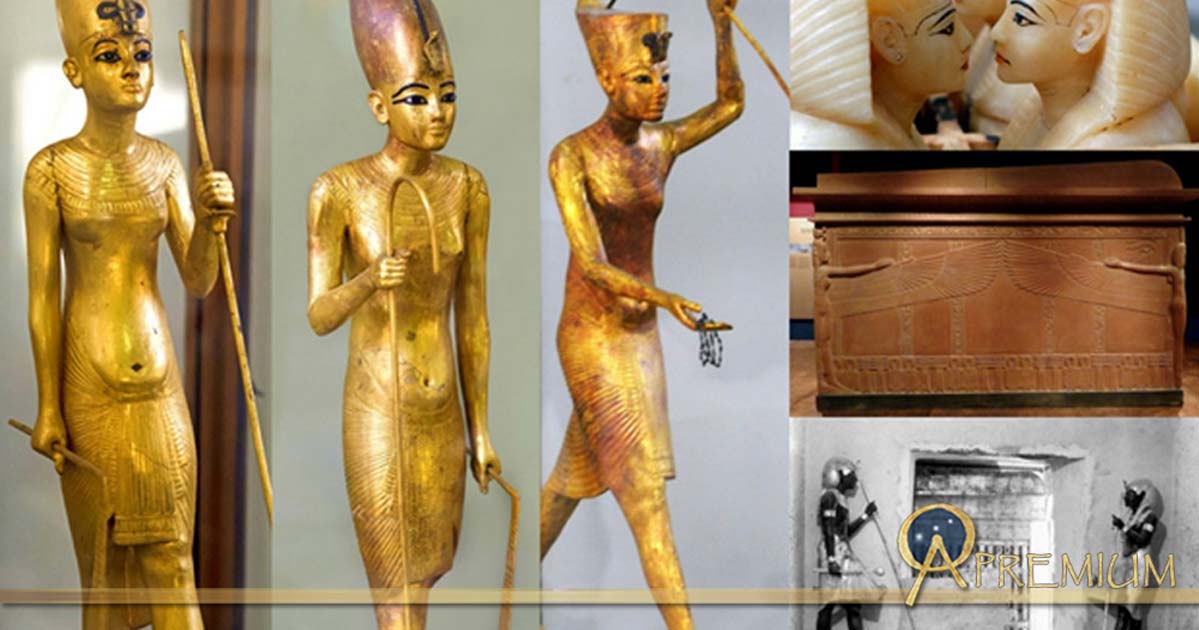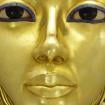Tutankhamun and the Age of Appropriation: Priceless Secrets and Palimpsests Hidden in Plain Sight–Part I
Among the stupefying hoard of over five thousand objects that were recovered from the tomb of Tutankhamun (KV62), some sported distinct Atenist leanings. While the golden throne of the boy-king is the most prominent in this regard, other treasures are no less sensational. It is the existence of palimpsests (where an artifact or text has been reused after original writing removed) on many artifacts that has intrigued Egyptologists for decades; mainly because they hint that a female pharaoh ruled before Tutankhamun.

Tutankhamun presided over the demise of the Amarna dream. This painted wooden head depicts him as the god Nefertem who springs from a sacred blue water lily at dawn; symbolizing the Sun God rising. Egyptian Museum, Cairo.
Akhenaten, the rebel pharaoh, had taken it upon himself to rid the pantheon of ancient Egyptian deities, reserving special hatred for the worship of Amun, the state god. He set about this enterprise of proscription around Year 8 or a little later. The promotion of the Aten as the sole deity did not arise out of a sudden epiphany, but, it was a well-planned move that was born out of both religious and political necessities. The subtle elevation of this hitherto minor god was actually set in motion by his father Amenhotep III, if not substantially by earlier pharaohs.

Detail of the beautifully sculpted face of one of Akhenaten’s colossal statues that was purposefully wrecked at Karnak Temple, when the shrines and sanctuaries he had dedicated to the Aten were dismantled during the Amarna backlash. Luxor Museum.
With him and his wife, Nefertiti, as intermediaries between the solar disc and the populace, Akhenaten hoped that the new–and rather unorthodox–religion would last for all eternity. But the daring experiment in the deserts of Akhetaten began to come apart at the seams even before the king died—and when he passed away a dozen years later; Atenism lost whatever little appeal it had garnered.

A limestone block from very early in Akhenaten’s reign shows the King making incense offerings to the Aten. The physiognomy and bizarre portrayals that marked his rule had not made their debut yet. Karnak. Egyptian Museum, Cairo.
EXIT AMARNA: QUESTION OF QUEENS
Up until the discovery of the Deir El-Bersha quarry graffito, Egyptologists believed that Nefertiti had either died, or had fallen from grace in or around Akhenaten’s Regnal Year 12 (her latest attested date), which coincided with the grand Durbar. But the graffito proved that she was still around in Year 16 as a Queen. Opinion remains divided among Egyptologists on the question of whether a female pharaoh, Ankh(et)kheperure Neferneferuaten, who seems to have held the reins of power in the interregnum between the Heretic’ death and young Tutankhaten ascending the throne, tried to make peace with the Amun priesthood. Many experts believe this to be true; and agree that she was Nefertiti, while Meritaten, too, has her fair share of adherents.

Thousands upon thousands of Talatat lie in the precincts of Karnak Temple. It will take a Herculean effort to piece this massive jigsaw puzzle. Yet, we have learned much about Akhenaten, Atenism and Amarna from many assembled blocks.
This theory is not without its proponents; evidence points to there having been definite attempts to return to orthodoxy. For instance, the famous Pawah graffito (TT139) dated to Regnal Year 3 of Neferneferuaten was written by a “lay-priest and scribe of god’s offerings of Amun in the temple of Ankhkheperure in Thebes.” The existence of offerings to Amun in this structure, perhaps her mortuary temple, has long been seen as proof that her reign extended for a time beyond that of Akhenaten, in whose final years Amun had been proscribed. So for at least three years, Nefertiti (or Meritaten) seems to have tried to find a middle path between the old polytheistic system and the new monotheistic one.
This FREE PREVIEW is just a taste of the great benefits you can find at Ancient Origins Premium.
Join us there ( with easy, instant access ) and reap the rewards: NO MORE ADS, NO POPUPS, GET FREE eBOOKS, JOIN WEBINARS, EXPEDITIONS, WIN GIFT GIVEAWAYS & more!
- Unraveling Tutankhamun’s Final Secret: Cloak of Mysteries Reside in a Sepulchral Masterpiece–Part I
- A Curious Case of Linen for Papyri—Lifting the Veil off the Lack of Written Materials in Tut's Tomb
- Daughter of Disaster: Unsung Ankhesenamun
Independent researcher and playwright Anand Balaji is an Ancient Origins guest writer and author of Sands of Amarna: End of Akhenaten.
Top Image: Collection of Egyptian Art, design by Anand Balaji (Photo credits: Heidi Kontkanen, Margaret Patterson, Harry Burton Archives); Deriv.
By Anand Balaji





















Comments
i request for more information on the indus valley civilisation